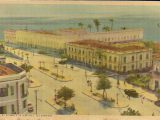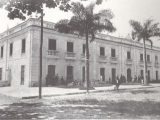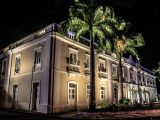Este post também está disponível em:
Português
English

The Palácio de La Ravardière or Palais de La Ravardière, built in 1689, was one of the first major buildings in the city and is the current administrative seat of the municipal government.
The Palácio de La Ravardière was listed by the historical heritage, is located in one of the most beautiful points of the city, the Praça Dom Pedro II, civic square of the city, since it houses the headquarters of the civil and religious powers, including the Palace of the Lions (State Government), Forum of Justice, the Cathedral of the Cathedral and the Episcopal Palace.
Discover an itinerary through the Upper City of São Luís do Maranhão.
Before being the seat of the city hall, the mansion served as the House of Chamber and Jail and after the change of function underwent some reforms that gave its current characteristics, among them one carried out in the 1930s, by the City Hall of São Luís, which sought to correct the defects of the buildings of the capital, also interfering in the structure of this building.
The remodelling some public spaces of the Palácio de La Ravardière aimed to adapt them to new conditions of use and hygiene, giving them salubrity.
However, it was also intended to adapt these spaces to the new technologies of transport (cars), services (lighting, sewers, etc.) and construction (concrete) that emerged at the beginning of the 20th century.
The most striking redesign of the Palais de La Ravardière took place at the City Hall headquarters, with the addition of workshops and “garages” for official cars.

In keeping with the city’s architectural tradition, the Palais de La Ravardière is not very tall.
There are only two floors, which used to house the jail and have now been adapted for the administrative work of the City Hall.
There is not much beauty there, perhaps due to the lack of organisation.
The façade of the Palace is asymmetrical with a shell and stylised acanthus leaves suggesting a small pediment. On the upper floor, the glazed windows have a balcony and are decorated at the top.
The decoration continues on the corbels that support the small balconies.
On the ground floor, the windows have a depressed arch with carved iron flags. The decoration, like that of the upper windows, will remain only on the main arch.

The staircase leading to the upper floor of the Palácio de La Ravardière is notable for its design and balustraded handrails. Recently, in the June 2013 demonstrations, the windows of the Palace were broken and replaced.
The name of the Palace is in honour of Daniel de La Touche, lord of La Ravardière, considered the founder of the city.
In front of the building is a bronze bust of the captain sculpted by the artist Bibiano Silva. On commemorative dates, the facade of the building receives decorative light effects, such as in Pink October and Christmas.
Tourism and Travel Guide of São Luís do Maranhão



















